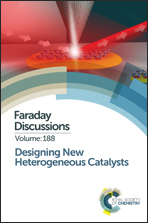Quantum chemistry of the oxygen evolution reaction on cobalt(ii,iii) oxide – implications for designing the optimal catalyst†
Abstract
Density functional theory is used to examine the changes in electronic structure that occur during the oxygen evolution reaction (OER) catalyzed by active sites on three different surface terminations of Co3O4. These three active sites have reactive oxo species with differing degrees of coordination by Co cations – a μ3-oxo on the (311) surface, a μ2-oxo on the (110)-A surface, and an η-oxo on the (110)-B surface. The kinetically relevant step on all surfaces over a wide range of applied potentials is the nucleophilic addition of water to the oxo, which is responsible for formation of the O–O bond. The intrinsic reactivity of a site for this step is found to increase as the coordination of the oxo decreases with the μ3-oxo on the (311) surface being the least reactive and the η-oxo on the (110)-B surface being the most reactive. A detailed analysis of the electronic changes occurring during water addition on the three sites reveals that this trend is due to both a decrease in the attractive local Madelung potential on the oxo and a decrease in electron withdrawal from the oxo by Co neighbors. Applying a similar electronic structure analysis to the oxidation steps preceding water addition in the catalytic cycle shows that analogous electronic changes occur during this process, explaining a correlation observed between the oxidation potential of a site and its intrinsic reactivity for water addition. This concept is then used to specify criteria for the design of an optimal OER catalyst at a given applied potential.
- This article is part of the themed collection: Designing New Heterogeneous Catalysts

 Please wait while we load your content...
Please wait while we load your content...